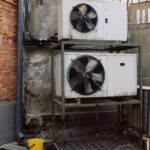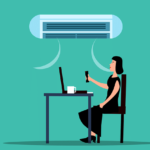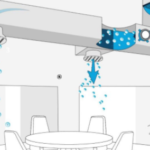6 Main Midwest Chiller Components
Midwest chiller components: There are chillers in almost every large commercial facility, and they provide great functions to ensure excellent and quality air. Although chillers come in various shapes and sizes, they all have the same essential components. Midwest Chiller Components
The primary Midwest chiller components are compressor, Condenser, Evaporator, Expansion Valve, Power Panel, Controls Unit, and Water Box. This post will explain where to find them on the chiller and briefly explain what they do.
Midwest chiller components are:-
Compressor
 The primary mover in the chiller system is the compressor, which generates a pressure differential to transport the refrigerant. Centrifugal, screw, scroll, and reciprocating compressors are the most popular types of refrigerant compressors. The advantages and disadvantages of each variety are different. The condenser is always situated between the evaporator and condenser.
The primary mover in the chiller system is the compressor, which generates a pressure differential to transport the refrigerant. Centrifugal, screw, scroll, and reciprocating compressors are the most popular types of refrigerant compressors. The advantages and disadvantages of each variety are different. The condenser is always situated between the evaporator and condenser.
Like a driving power, an electric motor may be mounted internally or externally on it. Typically, it is somewhat insulated. If you’re near a chiller, you’ll want to wear earplugs to protect your ears from the persistent droning sound of the compressor.
Condenser
 After the compressor and before the expansion valve comes the condenser. The condenser’s job is to extract the refrigerant’s heat from the evaporator, where it was captured. Air-cooled and water-cooled condensers are the two most common types of condensers.
After the compressor and before the expansion valve comes the condenser. The condenser’s job is to extract the refrigerant’s heat from the evaporator, where it was captured. Air-cooled and water-cooled condensers are the two most common types of condensers.
Water cooling condensers will repeatedly circulate “Condenser water” between their cooling tower. This water will absorb the hot refrigerant that comes out of the compressor, then transported up to the building and emitted.
Because of the pipe wall that separates the refrigerant from its water supply, they cannot come into direct contact with each other. If you’re looking for an alternative to an air-cooled chiller, the condensers are slightly different. Instead, they don’t use a cooling tower and blast air across exposed condenser pipes with refrigerant flowing inside them.
The expansion valve
Between the condenser and the evaporator, you’ll find the expansion valve. Its function is to reduce the pressure of the refrigerant and increase the fluid volume so that it can absorb the evaporator’s waste heat. All four most prevalent expansion valves may be found in one place: thermal, pilot-operated, and electronic expansion valves.
Evaporator
 The evaporator is responsible for capturing the unwanted heat from the building and transferring it to the refrigerant. It is located between the expansion valve and compressor and can be transferred to the cooling tower and rejected.
The evaporator is responsible for capturing the unwanted heat from the building and transferring it to the refrigerant. It is located between the expansion valve and compressor and can be transferred to the cooling tower and rejected.
The cooled water is pumped around the building to produce air conditioning. This “chilled water” returns to the evaporator with any undesired heat from the building, then removed by the refrigerant.
Can fix both the chiller and the power unit to the plant room wall with power cables running between them. Controlling the flow of electrical power to the chiller is a primary function of the power unit. Circuit breakers, speed controllers, and power monitoring devices are commonly found in these starters.
Controls Area
Typically, the chiller’s control panel is located on the chiller itself. Its primary function is to keep an eye on the chiller’s functioning and make modifications as necessary.
In a malfunction, the controls unit will notify the engineering team and safely shut down the system. For remote control and monitoring, BMS connections are also standard.
Water Box
The evaporators and condensers of water-cooled chillers are fitted with water boxes. In addition to directing water flow, the water box serves as a barrier to separating entry and departure points.
It is possible to have a water box with only one or two flanged entry or exit holes depending on the number of passes in the evaporator and condenser. To buy a chiller that will serve you for many years, begin here.
Contact us to know more about Midwest Chiller Components. We provide Best Midwest Chiller Components.

